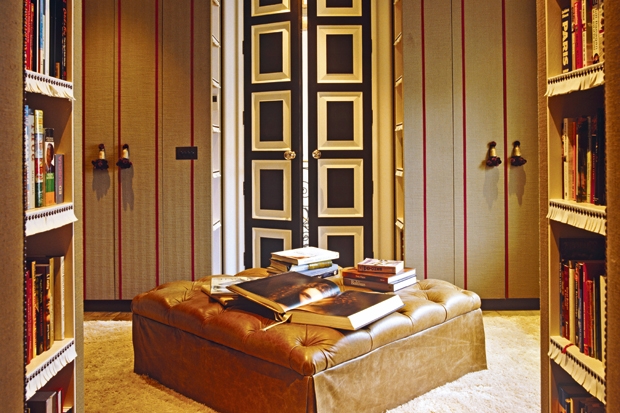Phaidon pioneered the modern art-book in 1936. The formula was: large format, fine production, exceptional plates, and essays by the superstars of German art history. After Richard Schlagmann acquired the imprint in 1990 Phaidon maintained, even enhanced, its reputation for good design, but visual style was prioritised over editorial substance and writers were marginalised. That is, more or less unwanted and, if wanted, not paid very well.
Since 2012 Phaidon has been owned by hedgie Leon Black. The interest in massive, high-concept illustrated product remains, but design and production have slipped. Or so I thought, effortfully working my through Room: Inside Contemporary Interiors, edited by Nacho Alegre and others (£49.95, Spectator Bookshop, £44.95). Ten designers and critics have been asked to nominate ten remarkable interiors from the past five years. Interesting stuff, but with iffy reproduction and chaotic design, the result is neither a visual treat nor, lacking essential maps, a useful practical guide.
Still if you wonder what critic Frederico Duarte and restaurateur-patron Alan Yau enjoy, here’s your answer. Duarte: Nestle’s Cookery School in Belo Horizonte’s central market by Marcelo Rosenbaum. Yau: James Plumb’s hipster haven in Shoreditch, a shop called Hostem which he describes as ‘ominous, atavistic beauty and otherworldly gothic drama’. Maybe writing is making a comeback at Phaidon.
Taschen is Phaidon’s big international art-book rival. Rock Covers (£44.99, Spectator Bookshop, £39.99) is a gigantic survey by record collectors Robbie Bush and Jonathan Kirby, assembled for the page by designer Julius Wiedemann. Like most Taschen books, its slight text is tri-lingual. The material is wonderful: the book jacket is the 1975 Hipgnosis’ Dark Side of the Moon for Pink Floyd and, inside, classics such as Richard Avedon’s portrait of Simon and Garfunkel for 1968’s Bookends. The subject merits so thorough and authoritative an account (over 750 albums are included) and caption details are good, but the layout is too busy and unsystematic to raise it from a source of nostalgia and curiosity to a work of reference. And, somehow, the murky reproduction does not capture the tactile and graphic drama of the originals. Or maybe distance is lending beauty to my view.
A dreamworld, perfumed by scented candles, is on offer from the splendid Nicky Haslam in A Designer’s Life: An Archive of Inspired Design and Decor (Jacqui Small, £50, Spectator Bookshop, £40). For those who thought a trip to B&Q would answer all interior design and entertaining questions, here is a corrective. Nicky has been to dinners where ‘50 guardsmen in Ruritanian uniforms lit the way upstairs with torches’. An eclectic mixture of scrapbook, photo album, apologia and top tips for decorating, the endpapers in faux handwriting offer the armchair voyeur a glimpse of the colossal Haslam address book: Sybille Bedford, Mark Birley, Cole Porter, Nancy Lancaster and Marilyn Monroe. Nicky Haslam is a one-man Gesamtkunstwerk, with as many costume changes as a Wagner opera. Reading this book is like nose-diving into a tasselled damask sack of pot pourri, and then being helped up by Bryan Ferry and Andy Warhol. Not familiar territory for B&Q man, which is, of course, the point.
Marilyn Monroe also appears — un-upholstered, indeed, completely undressed in a 1952 calendar — in what is the cheesiest book of this or perhaps any year. And when I say cheese, my reference point is suppurating Vacherin, not bland ricotta. Tom Kelley’s Studio (Reel Art Press, £45, Spectator Bookshop, £38) is a colourful album of pin-ups the old moustachioed rascal in a safari suit began photographing in the 1940s in his studio at 736 North Seward Street, Hollywood. If ever evidence were needed that the shape of women is dictated by culture as much as biology, Kelley has it.
There are, perhaps, 500 breasts and 250 bottoms in this book, very few of them matching contemporary norms. And lots, too, of matted fronds of pubic hair and virulent bushes which have, I think, long been out of fashion. The names too have resonant historical echo. Carol Ogden is on a flowered swing. Mamie van Doren on her mansion’s staircase. Amazing how so much erectile tissue can be unerotic, yet powerfully smutty. This is very bad stuff, therefore compulsive.
100 Buildings — 100 Years (Batsford, £25, Spectator Bookshop, £20) by Gavin Stamp and others is a nice, blameless, modest and uncomplicated palate-cleanser. The Georgian Group was founded in 1937, the Victorian Society in 1958 and the Thirties Society in 1979. Now re-branded as the Twentieth Century Society, it assumed curatorial responsibility for modern architecture at just the moment Modernism became an historical style-label. This is a selection of greatest hits since 1914 chosen by members: Dudley Zoo’s Bear Pit by Berthold Lubetkin; the Central Milton Keynes Shopping Building by Stuart Mosscrop and Christopher Woodward; vernacular housing at Ditchingham, Norfolk, by Tayler & Green. Its unsensational politeness reminds us how very quaint the notion of ‘modern’ has become.






Comments